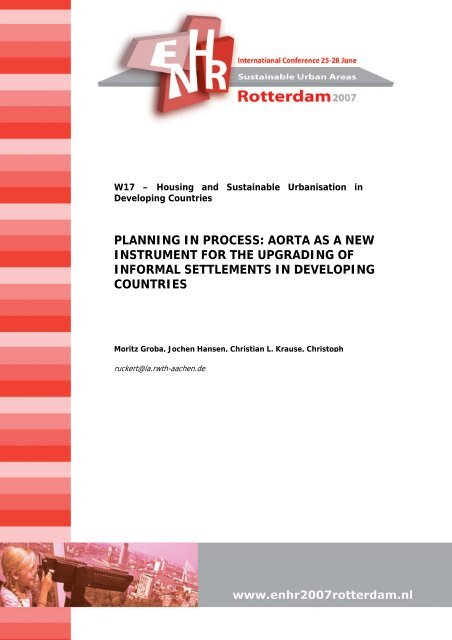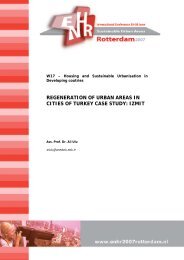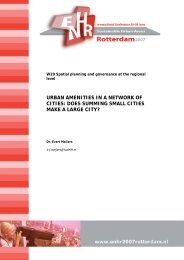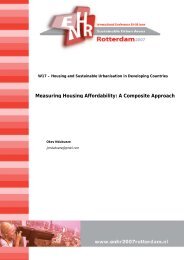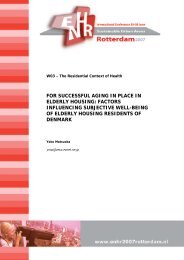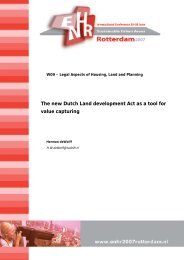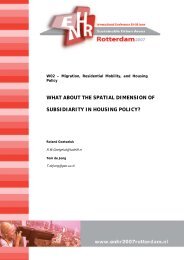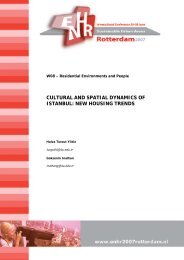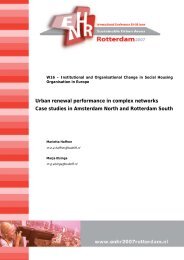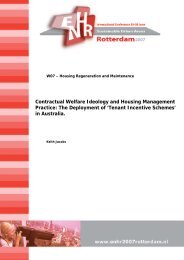Download - ENHR 2007 Rotterdam
Download - ENHR 2007 Rotterdam
Download - ENHR 2007 Rotterdam
You also want an ePaper? Increase the reach of your titles
YUMPU automatically turns print PDFs into web optimized ePapers that Google loves.
W17 – Housing and Sustainable Urbanisation in<br />
Developing Countries<br />
PLANNING IN PROCESS: AORTA AS A NEW<br />
INSTRUMENT FOR THE UPGRADING OF<br />
INFORMAL SETTLEMENTS IN DEVELOPING<br />
COUNTRIES<br />
Moritz Groba, Jochen Hansen, Christian L. Krause, Christoph<br />
ruckert@la.rwth-aachen.de
Planning in process: AORTA as a new instrument for the upgrading of informal settlements in developing countries<br />
<strong>ENHR</strong> <strong>2007</strong> International Conference ‘Sustainable Urban Areas’<br />
Planning in process: AORTA as a new instrument for the<br />
upgrading of informal settlements in developing countries<br />
Moritz Groba, Jochen Hansen, Christian L. Krause, Christoph Ruckert<br />
Department of Landscape Architecture<br />
RWTH Aachen University, Faculty of Architecture, ruckert@la.rwth-aachen.de<br />
Phone +49-241-8095053 Fax +49-241-8092274<br />
Keywords: Informal settlements; Slum upgrading; Infrastructure; Open space; Participation<br />
Abstract<br />
Due to their strong concentration of social, economic and ecological problems, informal<br />
settlements are of outstanding significance for the future development of urban<br />
agglomerations in developing countries. These quarters are mostly characterized by existential<br />
indigence, insufficient infrastructure and difficult living conditions. Main problems are the<br />
lack of basic supply, an inadequate hygienic situation, the missing access to education,<br />
information and medical support.<br />
In most cases, the development of these settlements is neither being initiated nor controlled by<br />
urban planning authorities. ‘Formal’ approaches as for example official housing programs<br />
often fail because of their lack of adaption to the economic and social requirements of the<br />
residents. Therefore planning instruments which are flexible enough to react to unexpected<br />
changes and decision making structures which are able to integrate all participants have to be<br />
developed.<br />
Planning interventions in informal settlements means reducing the final formulation of the<br />
plans to a minimum: an intervention that is characterized by its continuous proceedings,<br />
improving with every step and based on experience. Skills and potentials of local residents<br />
have to be supported and brought in action within the planning and construction process.<br />
Therefore, the main focus is on developing a system to satisfy the basic needs of the residents:<br />
an elevated infrastructural element with different add-on modules which can be used in<br />
various urban situations, combining social, technical and security functions. Structuring and<br />
upgrading the open space, it will serve as a development corridor in dense urban quarters as<br />
well as in non-defined vacant sites. This urban ‘AORTA’ reacts in a flexible way to growing<br />
communities and can be easily expanded. Participative tests in different settlement<br />
Workshop: Housing and Sustainable Urbanisation in Developing Countries<br />
Author: Moritz Groba, Jochen Hansen, Christian Krause, Christoph Ruckert<br />
1
Planning in process: AORTA as a new instrument for the upgrading of informal settlements in developing countries<br />
development scenarios with an 'AORTA toolbox' generate a sustainable basis for decision<br />
making of planning authorities and residents.<br />
Fig. 1: Perspective, design example of AORTA<br />
1 Introduction<br />
Urban and landscape planning in cities worldwide always means dealing with the<br />
phenomenon of informal settlements. In the beginning of the 21 st century about 1.000 million<br />
people – 30% of the world's urban population – live in such settlements without security of<br />
tenure. In threshold and developing countries this value can reach up to 50%. Prognoses say<br />
that – due to the ongoing urbanization – the number of people living in informal settlements<br />
can reach 2.000 million within the next 30 years. Problems in informal settlements are<br />
manifold: most households have only a low and sporadic income and the inhabitants are often<br />
excluded from political decisions and social processes. Access to public health care, to<br />
information and education is difficult; crimes and violence often menace the public order as<br />
well as the personal safety. Living conditions are mostly characterized by inadequate hygienic<br />
conditions and the lack of basic supply e.g. drinking water, electricity or communication<br />
systems. Houses are often made of insufficient material and most quarters have a very high<br />
population density. Public and private open spaces e.g. squares, streets, gardens or parks – the<br />
most important areas for social life in many countries – are rare and often in a bad state. Due<br />
to this strong concentration of social, economic and ecological problems and because of their<br />
high dynamic – the informal housing sector produces the majority of all new housing units in<br />
the cities of developing countries – informal settlements are of outstanding significance for<br />
the future development of urban agglomerations worldwide.<br />
1.1 Change of strategy<br />
In most cases, the emergence of these settlements is neither being initiated nor controlled by<br />
urban planning authorities. In many countries disregard or rejection of informal settlers have<br />
been the only reactions to the ongoing process of urbanization. Also many 'formal' planning<br />
approaches such as official housing programs failed because of their lack of adaption to the<br />
economic and social requirements of the residents. But changes in the strategy of problem<br />
solving appear: meanwhile more and more importance is attached to the upgrading of living<br />
conditions within existing informal settlements. The active involvement of local communities<br />
and their potentials and resources thereby become an existential part of the planning,<br />
implementation, monitoring and management process.<br />
1.2 A new instrument<br />
Considering the living conditions in informal settlements there are two aspects of increased<br />
significance for further development steps:<br />
2<br />
Workshop: Housing and Sustainable Urbanisation in Developing Countries<br />
Author: Moritz Groba, Jochen Hansen, Christian Krause, Christoph Ruckert
Planning in process: AORTA as a new instrument for the upgrading of informal settlements in developing countries<br />
• there is a fundamental need for basic infrastructure<br />
• the major part of private and public life in most developing countries takes part in<br />
open spaces<br />
On this basis a research team at RWTH Aachen University, Institute of Landscape<br />
Architecture developed AORTA as a new approach to the challenges of informal settlement<br />
upgrading: a linear infrastructural system which can be used in different urban situations,<br />
combining technical functions and social as well as economic components. It reacts to the<br />
dynamics and changes of growing communities in a flexible way. Defining, structuring and<br />
vitalising open space, it can serve as an initial development corridor for existing urban<br />
quarters as well as for non-defined vacant sites.<br />
2 The AORTA-CONCEPT<br />
The AORTA basically consists of an elevated infrastructural element, built on stilts,<br />
combined with different add-on modules. This elevated infrastructure creates a base pattern,<br />
which provides the basic needs, and at the same time defines and upgrades the public space in<br />
the settlements. Since crime is at an alarmingly high level in many informal settlements,<br />
upgrading the public space has to be seen as a very important step for generating a higher<br />
identification with the quarter and simultaneously strengthening the passive surveillance. In<br />
significant places, the AORTA extends to small squares with public facilities animating<br />
habitants to spend more time in public spaces.<br />
2.1 Basic infrastructure<br />
As water and electricity supply cannot be granted to every shack itself, the<br />
distribution is organized in several access stations along the AORTA,<br />
emphasizing the public places as focus points with strong attractiveness for the<br />
public. The construction of the infrastructural element is based on available resources.<br />
Recycled materials and retransformed elements are supposed to serve for its installation. It is<br />
low-tech enough to be set up by unskilled workers, but high-tech enough to serve its<br />
determination.<br />
Fig. 2: Collage<br />
In addition to the distribution of the basic needs like water and electricity, the AORTA can be<br />
equipped with various add-ons.<br />
2.2 Add-ons<br />
- Lighting and public phones<br />
Streetlights mounted on top in combination with the new public spaces will help to<br />
increase the passive surveillance along the AORTA and to lower the risk of getting<br />
Workshop: Housing and Sustainable Urbanisation in Developing Countries<br />
Author: Moritz Groba, Jochen Hansen, Christian Krause, Christoph Ruckert<br />
3
Planning in process: AORTA as a new instrument for the upgrading of informal settlements in developing countries<br />
into crime trouble. A dense network of public phones attached to the structure will also serve<br />
both purposes: to support the idea of the AORTA as a centre of social attraction and as a SOS<br />
beacon for emergency situations.<br />
- Transportation<br />
The lack of public transport and the general transportation problems in<br />
informal settlements handicaps habitants’ access to work, accommodation and<br />
education. Increasing the speed of moving forward from 5 km/h by foot to 15<br />
km/h by bike, the area to be reached in one hour is multiplied by factor 9. Along the aorta, a<br />
network of bicycle repair shops can be installed, to give sufficient support for bicycle users.<br />
The repair shops offer courses in bicycle repair and provide new employment places for the<br />
local inhabitants. Adjacent to the bicycle–network, a system of shuttle buses will work along<br />
the aorta. Sufficient light for a safe waiting process is given by the AORTA lighting system.<br />
Bus stops can be integrated and sheltered by small AORTA roofs.<br />
- Community cooling devices<br />
As a reaction to the very bad hygienic situation, especially concerning food storage,<br />
community cooling devices, powered by solar energy, can be installed as part of the<br />
AORTA. Cooling is one of the few applications that consume the most energy when<br />
solar panels are most efficient: at daytime. The devices can be made up of second hand reefer<br />
container, a mass product, used all over the world to transport delicate goods such as fruits,<br />
meat or flowers. These reefer containers are the ideal application for solar cells: provided with<br />
the maximum energy output at daytime and keeping the coldness inside at night by isolation.<br />
The use of expensive storage batteries can be reduced to a minimum or even cancelled.<br />
- Orphanage modules<br />
Due to the alarming spreading of AIDS, more and more children have to grow up<br />
without their biological parents, often also infected with the HI virus. This growing<br />
group and other children living without their parents for different reasons on the<br />
street, needs to be reintegrated into the society and adequately supplied with medical and<br />
social attendance. Therefore special orphanage modules shall be set up along the AORTA,<br />
supervised by a social worker. In strong correlation with for instance the bike repair network<br />
or the community cooling devices, training programs shall be set up, to show the adolescents<br />
how to assume responsibility and prevent them from engaging in criminal activities. These<br />
orphanage modules can be made out of used TFU (twenty feet units) ship containers, piled up<br />
shifted, to form small balconies and shaded open-air spaces.<br />
- Internet Boxes<br />
The internet grants access to uncensored information from all over the world and<br />
facilitates global communication. That is the reason why the AORTA takes on the<br />
project of the “community–chat” internet–boxes, already applied in South African<br />
informal settlements. With the AORTA a network of internet boxes will be set up, allowing<br />
the habitants to benefit from the manifold and independent information sources the internet is<br />
providing.<br />
- Community Centres<br />
At important public focus points community–centres will be installed. These<br />
are assembly spaces where general meetings can be held and social workers<br />
transmit information regularly. The habitants shall be introduced to a<br />
sustainable treatment of their living area, concerning waste treatment, food gardening, solar<br />
cooking and the construction of biogas–plants for instance. These technologies have already<br />
Workshop: Housing and Sustainable Urbanisation in Developing Countries<br />
Author: Moritz Groba, Jochen Hansen, Christian Krause, Christoph Ruckert<br />
4
Planning in process: AORTA as a new instrument for the upgrading of informal settlements in developing countries<br />
been successfully applied in different developing countries. Therefore, it is important to<br />
mediate such projects tending to support the self–sufficiency and a more agreeable<br />
environment. The centres shall be points of exchange of ideas and experiences, as well as<br />
meeting points where public events such as conferences, culture happenings or concerts can<br />
take place.<br />
- Medical Centres<br />
To guarantee sufficient medical provision, such as help in small emergencies or<br />
selling medicine, as well as giving information on medical topics, e.g. the very urgent<br />
AIDS problem, small medical centres can be added to the AORTA structure.<br />
- Community Kitchen<br />
In informal settlements cooking is mainly done with open fire. This endangers not<br />
only the health of the user and the safety of the whole closely tilled quarter, but also<br />
wastes valuable resources. As a part of the AORTA, small community-kitchen will be<br />
added, where people can organize cooking in groups, using the electricity delivered by the<br />
AORTA. In that way cooking is more effective and lowers the risk of a major fire. In further<br />
steps, the kitchen modules can be equipped with cookers, powered by regenerative energy.<br />
This energy could be gained from biogas, produced by the habitants themselves, or with the<br />
help of focused solar radiation. Information on both techniques will be given by the<br />
community centers.<br />
- Grey water system<br />
An additional third strand, beside electricity and fresh water, can be attached for the transport<br />
of grey water. Collected from purification plants and rain, grey water will be used to irrigate<br />
small urban agriculture fields and will serve as an emergency system to extinguish fires in<br />
dense quarters.<br />
3 Intervention process<br />
3.1 Groundwork principles of the AORTA<br />
Intervening in an existing urban formation is a delicate but challenging venture. Its complex<br />
structure always reacts unpredictably and fragile equilibrations can easily become unbalanced.<br />
The planning of ready-made settlements like the South African 'Matchbox House' projects has<br />
to be seen critically, as for often neither acceptance nor identification is achieved within the<br />
artificial urban quarters. Therefore the AORTA intervention process must be a strategy of<br />
small steps according to the needs and major problems of the people. An intervention that is<br />
characterized by its continuous proceeding, improving with every step, based on experience.<br />
The strategy of small steps and “grassroots technology” helps to ensure, that the basic<br />
decisions are kept within the community and its people. Instead of presenting ready-made<br />
recipes, solutions developed together, shall be qualified further on.<br />
3.2 Involving the habitants<br />
The squatters` high level of talents and potentials, ranging from self-sufficiency, creativity,<br />
motivation to self-reliance and organisation-ingeniousness, has to be supported and brought in<br />
action. This means organizing the habitants in effective basic-networks and developing a<br />
group spirit, which is for the benefit of everyone. Social integration and responsibility has to<br />
be a must, guiding to identification with the group and its community. An important focus has<br />
to be set on caring together for the needs of the socially disadvantaged, like AIDS-orphans,<br />
children and older people.<br />
Workshop: Housing and Sustainable Urbanisation in Developing Countries<br />
Author: Moritz Groba, Jochen Hansen, Christian Krause, Christoph Ruckert<br />
5
Planning in process: AORTA as a new instrument for the upgrading of informal settlements in developing countries<br />
3.2.1 The basic networks<br />
First of all, the community spirit is to be encouraged to convince everyone that the future<br />
intervention is for the best of every single inhabitant. Then spokesmen are elected to start the<br />
planning phase. Depending on the size of the community their number should be large enough<br />
to prevent decisions that are based on specific personal interests, but small enough to keep up<br />
a high spirit of community and the possibility for an effective operation potential. Together<br />
with specialists for urban planning and technical engineers, they form a council to deliberate<br />
on further steps.<br />
4 The AORTA toolbox<br />
4.1 Communication problems during the planning process<br />
A great obstacle in communication between planners and habitants is the lacking capability of<br />
the habitants in reading and understanding technical plans. 3d Computer animations may be<br />
impressive for presentation, but create a fixed final state which is difficult to accommodate to<br />
the circumstances, as the handling of the software requires high specification and skills. For<br />
involving the public in the decisions, a new platform for communication and discussion has to<br />
be developed: The “AORTA toolbox”, a communication tool, easy to handle, applicable<br />
intuitively, that fills the gap and allows both parties to express themselves, putting their ideas<br />
across. It provides a collection of materials and icons to act as a construction kit in a selfmade<br />
demonstration model.<br />
4.2 Getting started<br />
With today's internet technology, satellite and aerial photographs of nearly every point of the<br />
earth are easily available and at hand in an excellent quality. The satellite photo of the<br />
operational area is glued in a reasonable scale, e.g. 1:200, on a soft material, like a plate of<br />
cork or styrofoam.<br />
First of all the existing urban structure is rebuilt with semiabstract items. These items are as<br />
close as possible to the archetype to be understood by everyone, but abstract enough to act as<br />
a symbol. E.g. a single shack, in the model made out of folded beverage cans, underlines the<br />
coherency of the archetype to be pictured, but still can be read as a simple geometric volume.<br />
a.beverage can b.cut to open c.winding off d.cutting out e.folding f.pricked needle into the “shack”<br />
Fig. 3: Building a shack model<br />
Workshop: Housing and Sustainable Urbanisation in Developing Countries<br />
Author: Moritz Groba, Jochen Hansen, Christian Krause, Christoph Ruckert<br />
6
Planning in process: AORTA as a new instrument for the upgrading of informal settlements in developing countries<br />
Furthermore, all used items are made on site and produced out of low-cost materials which<br />
are easily disposable in the operational area.<br />
a. loudspeaker double core cable b. car grille c. car air filter d. old pharmaceuticals e. sponge brush f. beverage can g. eraser h. plastic wine bottle sealing i. sponge j. electronic component<br />
k. cork l. charcoal m. used computer keyboard n. styrodur m. styrofoam p. wax<br />
Fig. 4: Material proposals<br />
After all dwellings have been rebuilt in the model, existing infrastructure has to be<br />
symbolized and decisive points of special interest displayed. As streets and foot paths can be<br />
seen in the aerial photograph, just important elements for the daily life are accentuated, e.g.<br />
water access points, bus stops, groceries, schools, dumping places etc. Therefore a set of icons<br />
has been developed, precise enough to be understood by everyone, abstract enough to be<br />
grasped very quickly. This icon-set is extendable or modifiable by the planning crew to adapt<br />
to the prevalent imagination of the archetype. A first set of proposals can be printed out of the<br />
internet.<br />
4.3 Intervening<br />
When the status quo is mapped sufficiently, people can start to give several settings a try.<br />
Therefore the “AORTA toolbox” holds various elements ready to be pricked into the model.<br />
a. community-centre b. orphanage-module c. cooling-device d. internet-box e. bike-repair f. medical-centre g. community-kitchen h. bus-stop i. roof-outstanding j. AORTA<br />
Fig. 5: Selection of prepared add-on items<br />
Different add-ons are proposed to be made out of different materials. To underline the specific<br />
intervention, symbols from the icon-set are pricked on top of the elements. Now the user can<br />
simulate different scenarios, figuring out the correlation between each intervention step and<br />
realizing the direct consequences for him and his neighborhood.<br />
Workshop: Housing and Sustainable Urbanisation in Developing Countries<br />
Author: Moritz Groba, Jochen Hansen, Christian Krause, Christoph Ruckert<br />
7
Planning in process: AORTA as a new instrument for the upgrading of informal settlements in developing countries<br />
5 Scenarios<br />
The upgrading of informal settlements – as well as city development in general – is a<br />
continuous process that can never be fixed in a certain state. For this reason, an intervention<br />
instrument like AORTA cannot be 'planned' in a conventional way: as we have shown in<br />
previous chapters, different factors influence the conceptual design and the implementation<br />
phase. For this reason, every development step has to be adapted to the current situation and<br />
changes must be made according to relevant monitoring results.<br />
The following scenarios are therefore just examples for the application of the AORTA<br />
toolbox. Nevertheless they are based on an existing informal settlement in Cape Town, South<br />
Africa. The flexibility of the AORTA concept will be pointed out by means of two different<br />
development scenarios.<br />
Fig. 6: Initial situation<br />
5.1 Scenario 1: Upgrading with caution<br />
In the first phase, the main strand is applied to 'important' streets of the quarter. Each 'block' is<br />
pervaded or surrounded by an AORTA line and street crossings form a central public square.<br />
Along this course basic supply is being provided with distribution stations for water and<br />
electricity. The latter can also be used by a semi-public kitchen for several neighbouring<br />
houses. The square in the middle of the quarter is being equipped with public facilities e.g. an<br />
internet-box, an information bureau and a community centre for public meetings.<br />
Fig. 7: Step 1<br />
In a second step, the AORTA can be led into the blocks so that shacks in second and third row<br />
can also be provided with water and electricity. The public infrastructure is being expanded<br />
Workshop: Housing and Sustainable Urbanisation in Developing Countries<br />
Author: Moritz Groba, Jochen Hansen, Christian Krause, Christoph Ruckert<br />
8
Planning in process: AORTA as a new instrument for the upgrading of informal settlements in developing countries<br />
by community cooling devices, a medical centre and an orphanage module. First tree<br />
plantings contribute to the design and the upgrading of green open spaces.<br />
Fig. 8: Step 2<br />
In the course of the process, the coverage of the whole quarter with public infrastructure can<br />
be completed. Roofing along the AORTA provides distribution stations for water and<br />
electricity as well as places for markets or small shops. The design of open squares is being<br />
upgraded with trees and seating-accommodations.<br />
Fig. 9: Step 3<br />
5.2 Scenario 2: Forming and vitalising space<br />
This scenario simulates a spatial decongestion of the quarter. In the first step, the AORTA is<br />
also being geared to main streets, but sporadically shacks have been removed to create new<br />
public spaces and to provide more infrastructural supply. In the beginning mainly water and<br />
electricity distribution as well as a community centre with several services for the public are<br />
made available.<br />
Fig. 10: Step 1<br />
Workshop: Housing and Sustainable Urbanisation in Developing Countries<br />
Author: Moritz Groba, Jochen Hansen, Christian Krause, Christoph Ruckert<br />
9
Planning in process: AORTA as a new instrument for the upgrading of informal settlements in developing countries<br />
The second phase is characterized by the development of the AORTA into the quarter. The<br />
AORTA's course, in combination with further displacement of shacks forms small squares or<br />
'pocket-parks'. The infrastructural offer such as internet boxes is being enlarged and<br />
supplemented by small private businesses.<br />
Fig. 11: Step 2<br />
'Finally', the AORTA completes the quarter's infrastructural supply and the formation of open<br />
spaces. The utilisation of these green spaces varies from small sport fields to playgrounds or<br />
community food gardens. Additional public devices as well as private shops and markets join<br />
the AORTA's infrastructural nucleus: a momentum has been established, which assures the<br />
self-contained further development of the quarter.<br />
Fig. 12: Step 3<br />
6 Conclusions<br />
The aim of AORTA as an instrument of urban development is to improve the living<br />
conditions of people in informal settlements in a fast and uncomplicated way. This threedimensional<br />
infrastructural element is able to provide the basic energy and water supply<br />
without the need for big encroachment in the existing settlement structure. Optional add-on<br />
modules assure a development that is continuously adapted to the particular circumstances,<br />
amending the existing infrastructure. Besides its functional quality, the AORTA helps to<br />
define and upgrade public open spaces, creating a higher identification with the quarter. The<br />
decisions in the process of planning and intervening are assigned to the local people by means<br />
of the AORTA „toolbox“, a new instrument of communication between planning specialists<br />
and habitants.<br />
Only by realizing that the support of the whole community is needed, sustainable<br />
improvements can be achieved. Team spirit and community motivation are key factors for a<br />
10<br />
Workshop: Housing and Sustainable Urbanisation in Developing Countries<br />
Author: Moritz Groba, Jochen Hansen, Christian Krause, Christoph Ruckert
Planning in process: AORTA as a new instrument for the upgrading of informal settlements in developing countries<br />
development to the better. The AORTA concept is the fundament for an autonomous activity<br />
within the community, taking advantage of the existing human, technical and material<br />
resources and generating a vitalised base for future perspectives.<br />
References<br />
Günter Meinert (2005). Slum-Upgrading – die Verbesserung von Lebensbedingungen in<br />
informellen Siedlungen. Available: www.gtz.de/de/dokumente/de.flyer-slumsanierung.pdf<br />
Rainer Nordberg (2005). Alleviating Poverty Through Housing Development. Available:<br />
www.unhabitat.org/HD/hdv6n4/alleviating_poverty.htm<br />
Sylvie Lacroux & Laura Petrella (2005). The Informal City and Security of Tenure.<br />
Available: www.unhabitat.org/programmes/ifup/tenure.htm<br />
Workshop: Housing and Sustainable Urbanisation in Developing Countries<br />
Author: Moritz Groba, Jochen Hansen, Christian Krause, Christoph Ruckert<br />
11


